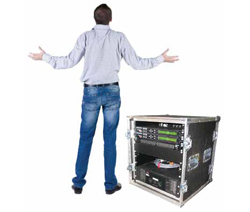
Often, it’s a simple device like a cooling fan in an amplifier that fails, sometimes many years before the other components. Fans fail because they become permeated with dust but also, some amplifier companies operate their fans at too high of a voltage in order to cool inadequately sized heatsinks.
This is a basic design flaw that’s not rare enough. Running a 24-volt fan at 28 volts greatly increases the airflow but radically shortens the life of the motor, usually by an order of magnitude. A 20,000-hour MTBF can easily become 2,000 hours, which is less than a year of 9-to-5 office work.
In such cases it’s clear that the manufacturer has simply not looked at reliability in the same way that an aerospace or aeronautics company would be forced to do, given the life-safety issues required in those fields.
Thermal Considerations
Heat is the enemy of electronics. Serious pro products should be tested in temperatures that match or exceed the highest and lowest values that the product might ever encounter.
The Burningman Festival, as one example, is held deep in the Northern Nevada desert with daytime temperatures that can reach 120 degrees Fahrenheit and rarely drop below 90 degrees (F). The system in the central café runs 24 hours a day for eight days, literally around the clock.
Testing a product at 100 degrees for an hour or two is not a valid confirmation of its ability to operate properly for extended periods in significantly greater heat. Check your supplier’s data very carefully, and consider running your own tests if you plan to work in extreme climatic conditions.
On Or Off?
It used to be common to keep consoles, outboard equipment, and amplifiers powered up day and night, 24/7. This practice originated in recording studios where massive analog consoles took many hours to reach a stable operating temperature. Alterations in the way that analog EQ circuits behaved were often quite noticeable as the temperature gradient changed.
Older, passively cooled amplifiers were also thought to alter their sound quality after warm-up, and in those days all outboard equipment was analog, including many with vacuum tubes, subject to similar issues especially when stacked closely together causing mutual heating.
But today things are quite different. Digital consoles have far less circuitry than their analog predecessors. Temperature variances will not alter how a DSP processes signals; only the analog I/O circuits will be affected and except in extreme conditions, any changes that occur will be imperceptible. The same goes for fan-cooled amplifiers.
So firing up the system an hour or so before use is a perfectly acceptable practice. By leaving the devices “off” two things are accomplished: first, the hours of use that eat into the total life span of the components will not accumulate at the same rate as the calendar pages; second (and this is very important), any electronic device that’s connected to the AC mains in a powered-up state has a statistically greater exposure to voltage spikes, brownouts, a lighting hit, and other nastiness coming down the electrical pike. There’s no reason to wear out equipment prematurely or expose it to voltage fluctuations when there’s no advantage in doing so.

